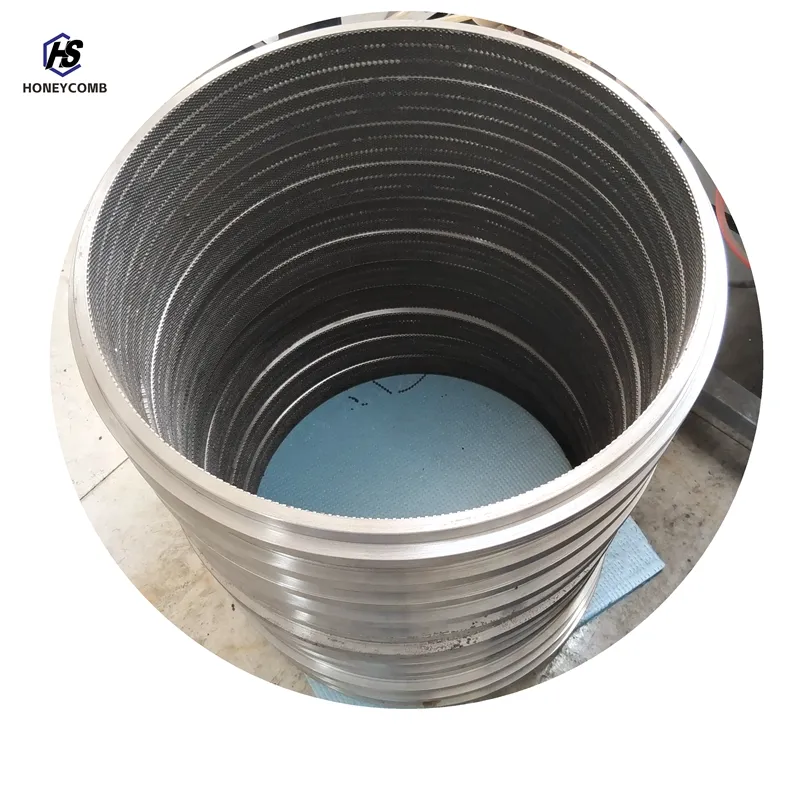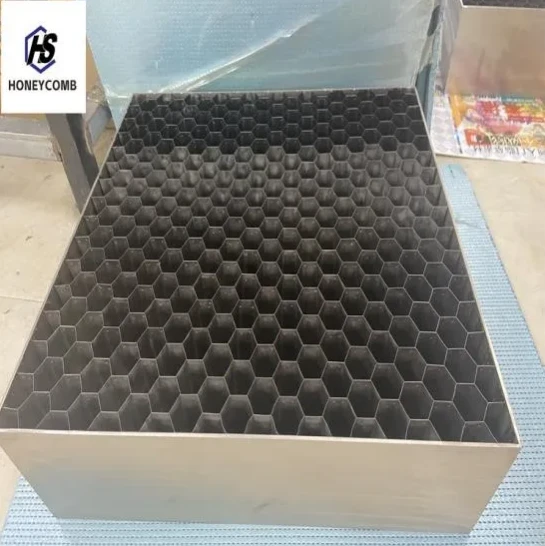
- Afrikaans
- Albanian
- Amharic
- Arabic
- Armenian
- Azerbaijani
- Basque
- Belarusian
- Bengali
- Bosnian
- Bulgarian
- Catalan
- Cebuano
- China
- China (Taiwan)
- Corsican
- Croatian
- Czech
- Danish
- Dutch
- English
- Esperanto
- Estonian
- Finnish
- French
- Frisian
- Galician
- Georgian
- German
- Greek
- Gujarati
- Haitian Creole
- hausa
- hawaiian
- Hebrew
- Hindi
- Miao
- Indonesian
- Italian
- Japanese
- Javanese
- Malay
- Persian
- Portuguese
- Punjabi
- Russian
- Spanish
- Swahili
- Telugu
- Vietnamese

High Performance Steel Honeycomb Solutions Stainless Steel Honeycomb Pan Supplier & Mesh Manufacturer
- Introduction to steel honeycomb: overview and growing importance
- Technical advantages and unique features of steel honeycomb structures
- Comparative analysis: stainless steel honeycomb products vs. alternatives
- Leading suppliers and manufacturers: performance, price, and certification comparison
- Customized steel honeycomb solutions for advanced industry needs
- Real-world applications and case studies: from aerospace to defense
- Future prospects and technological frontiers for steel honeycomb

(steel honeycomb)
Steel Honeycomb: Revolutionizing Industrial Architecture
Over the past decade, steel honeycomb structures have redefined the standards of durability, lightweight performance, and versatility in demanding industries. Their unique geometry offers an exceptional strength-to-weight ratio, making them crucial in applications where both rigidity and reduced mass are paramount. Recent surveys by the Materials Research Society showed that the use of high-performance stainless steel honeycomb panels rose by 35% between 2018 and 2023, with anticipated sustained growth as more sectors, from transportation to military, recognize their potential. The ongoing evolution of these materials has positioned steel honeycomb at the forefront of architectural, aerospace, and defense solutions, fueled by both innovation and necessity as sustainability and performance coalesce.
In this article, we explore the technical prowess, comparing industry-leading manufacturers, showcase possibilities in customization, document intensifying real-world usage, and project the future trajectory of steel honeycomb technologies.
Unmatched Technical Advantages and Engineering Benefits
At the heart of the steel honeycomb's appeal is its intricate cellular matrix, inspired by naturally occurring honeycomb patterns found in beehives. This deliberate structure imparts outstanding mechanical properties: for example, a typical 304-grade stainless steel honeycomb panel can achieve a compressive strength exceeding 15 MPa while weighing only 6 kg/m2—outperforming traditional solid steel sheets by over 60% in strength-to-weight efficiency.
- Thermal Efficiency: The air gaps in honeycomb cells provide insulating properties, making these panels preferred in environments susceptible to thermal extremes.
- Corrosion Resistance: Advanced surface treatments render stainless steel honeycomb meshes resistant to harsh chemicals and marine atmospheres, thereby minimizing maintenance cycles by up to 40% compared to solid metal sheets.
- Acoustic Dampening: Complex cellular structure disperses sound waves, reducing noise transfer in aerospace and construction settings.
- Shock Absorption: Military grade panels are proven to absorb up to 33% more kinetic energy in ballistic and blast testing relative to non-honeycomb metallic shields.
Additionally, the environmental impact is notably lesser: production life-cycle analyses suggest carbon emissions for stainless steel honeycomb are up to 25% lower than for traditional solid steel panels, especially when recycled content is used.
Stainless Steel Honeycomb vs. Alternatives: A Data-Driven Comparison
In applications ranging from cookware to aerospace, material selection impacts not only performance, but lifecycle cost and sustainability. Below is a comparative table detailing key performance indicators between high performance stainless steel honeycomb, aluminum honeycomb, and traditional steel sheets:
| Parameter | High Performance SS Honeycomb | Aluminum Honeycomb | Traditional Steel Sheet |
|---|---|---|---|
| Density (kg/m2) | 5.7 - 8.2 | 3.1 - 4.6 | 25 - 30 |
| Compressive Strength (MPa) | 15 – 29 | 8 – 18 | 12 – 21 |
| Thermal Conductivity (W/m·K) | 13 – 16 | 165 – 200 | 50 – 55 |
| Corrosion Resistance (1-10) | 9 | 5 | 4 |
| Price Range (USD/m2) | 32 – 45 | 25 – 40 | 20 – 28 |
| Noise Reduction (dB) | Up to 28 | Up to 18 | Up to 11 |
| Service Life (years) | 30 – 50 | 20 – 35 | 12 – 25 |
The data underscores that while stainless steel honeycomb products may carry a higher initial cost, their longevity and low maintenance requirements consistently justify the premium for critical applications. In cookware, high performance stainless steel honeycomb pan suppliers often emphasize reduced sticking and increased lifespan compared to non-stick alternatives, which typically degrade after 2–3 years.
Performance, Pricing, and Certifications: Leading Suppliers Assessed
Selecting the right supplier is essential for both large-scale infrastructure and specialty manufacturing. Let's examine some leading names in the domain of steel honeycomb panel and mesh supply, focusing on high performance, pricing, and industry certifications:
| Supplier | Product Focus | ISO Certification | Military Grade Compliance | Avg. Lead Time (days) | Price Tier |
|---|---|---|---|---|---|
| SteelCore Solutions | Stainless Steel Honeycomb Mesh | ISO 9001:2015 | Yes: MIL-STD-810 | 30 | Mid-High |
| HexaTech Manufacturing | Honeycomb Panels (Defense, Aero) | ISO 14001, ISO 9100 | Yes: MIL-DTL-24441 | 24 | High |
| EcoPanel Fabricators | Cheap Stainless Steel Honeycomb Mesh | ISO 9001:2015 | No | 14 | Budget |
| TriStar Materials | General Purpose Honeycomb | ISO 9001:2015 | Partial | 18 | Mid |
For projects requiring conformance to military grade datasheets, such as ballistic shielding or defense structures, selecting a supplier with full MIL-SPEC compliance is paramount. However, for large-volume civil projects, reputable but cheap stainless steel honeycomb mesh manufacturers ensure fast turnaround and cost efficiency, albeit sometimes at the expense of specialized certifications.
It's critical to evaluate internal lab test data, client testimonials, and production capacity before finalizing procurement to guarantee fit-for-purpose delivery.
Tailoring Steel Honeycomb Solutions: From Conception to Execution
Owing to its modular nature, steel honeycomb can be precisely engineered to suit project-specific demands. Leading suppliers offer custom thicknesses ranging from 3 mm to 120 mm, various cell diameters (from 3 mm for filtration applications up to 25 mm for load-bearing panels), and finishes—such as anodizing or PTFE coatings—for additional protection.
Custom options include:
- Material Grade Selection: High performance stainless steel honeycomb panels are typically made using 304 or 316L grades, balancing resistance, malleability, and cost.
- Geometric Customization: Variable cell size, orientation, and double-hex designs for enhanced directional strength.
- Edge Bonding & Integration: Advanced adhesives, laser welding, or mechanical fasteners to suit environmental and load demands.
- Hybridization: Combining stainless steel honeycomb with polymer skins for vibration insulation or lightweight cores for extreme aero applications.
Prototyping and small-batch runs are often available for specialized aerospace or medical-grade deployments, reflecting the ecosystem's agility in addressing unique customer requirements.
Implementation Scenarios: Steel Honeycomb in Action
The proven track record of steel honeycomb spans a range of industries. In aerospace, for instance, honeycomb panels reduce airframe weight by up to 18%, directly translating into fuel savings estimated at $72,000 per aircraft annually (Boeing 2022 Sustainability Report). The defense sector leverages military grade steel honeycomb panels for armored vehicle floors and blast-resistant barriers, crucially increasing occupant survivability in conflict zones.
Case Study 1: Urban Infrastructure
During the 2021 redevelopment of the Fulton Street Transit Hub, engineers replaced legacy steel sheeting with honeycomb-structured panels, achieving a 27% reduction in gross wall weight and a 46% improvement in acoustic dampening. Maintenance records from 2022 show a halved replacement frequency compared to historical patterns.
Case Study 2: Commercial Cookware
Leading high performance stainless steel honeycomb pan suppliers document that their products sustain non-stick properties even after 120,000 abrasive cycles, more than 8x the durability of PFAS-based coatings.
Case Study 3: Military Barriers
According to a 2023 NATO assessment, field-deployed military grade steel honeycomb panels enhanced blast protection 31% above standard steel barricades. The accompanying datasheet also highlighted a 22% decrease in panel fatigue after 10,000 pressure shock cycles.
The Future Landscape: Steel Honeycomb Technologies Pave the Way
As we look ahead, the role of steel honeycomb as a transformative material continues to expand. Researchers are developing next-generation honeycomb alloys incorporating titanium and advanced stainless steel blends, yielding even greater fatigue resistance and corrosion stability for critical industries. Emerging trends include smart honeycomb panels with embedded sensors for real-time structural health monitoring, and the adoption of additive manufacturing for lattice optimization—projected to reduce production costs by up to 17% over the next five years.
The matured ecosystem, comprising high performance stainless steel honeycomb pan suppliers and budget mesh manufacturers alike, ensures solutions for every segment—from cost-conscious bulk orders to bespoke, military grade panel applications guided by stringent datasheet parameters. With demonstrated success in energy, defense, mobility, and manufacturing, the pace of steel honeycomb innovation shows no sign of slowing, promising a future where lightweight strength and environmental responsibility are synonymous.

(steel honeycomb)
FAQS on steel honeycomb
Q: What are the key benefits of using steel honeycomb in high-performance applications?
A: Steel honeycomb offers excellent strength-to-weight ratio and superior durability. Its unique structure provides enhanced thermal and impact resistance. This makes it ideal for aerospace, military, and advanced engineering uses.Q: How do I find a reliable high performance stainless steel honeycomb pan supplier?
A: Look for suppliers with industry certifications and positive customer reviews. Ensure they offer high-grade materials and customizable options. Request product samples or datasheets to confirm quality before purchasing.Q: Are there affordable options from cheap stainless steel honeycomb mesh manufacturers?
A: Yes, several manufacturers offer cost-effective honeycomb mesh products without compromising essential quality. Compare prices and specifications from different suppliers. Bulk purchasing often results in further discounts.Q: Where can I obtain a military grade steel honeycomb panels datasheet?
A: Most reputable suppliers provide detailed datasheets upon request via their website or customer service. These datasheets include technical properties, certifications, and application guidelines. Always verify data authenticity before ordering.Q: What distinguishes military grade steel honeycomb panels from standard panels?
A: Military grade panels use higher tensile strength steel and are rigorously tested for extreme conditions. They feature enhanced corrosion resistance and superior structural integrity. This ensures optimal performance in defense and aerospace sectors.Products categories
-
Why Vented Aluminum Honeycomb Is Leading the Way in Shielding and Ventilation SolutionsNewsJul.18,2025
-
Why Stainless Steel Honeycomb Panel is the Ultimate Choice for High-Tech Shielding and ProtectionNewsJul.18,2025
-
Why Honeycomb Strips Are Revolutionizing High-Speed Sealing SolutionsNewsJul.18,2025
-
Shielded Glass Innovation Powers the Future of Electromagnetic ProtectionNewsJul.18,2025
-
Precision Starts Here: Revolutionizing Airflow Control with Honeycomb Wind Tunnel SolutionsNewsJul.18,2025
-
Elevate Industrial Performance with Precision-Engineered Steel Honeycomb Core SolutionsNewsJul.18,2025
-
Vented Aluminum Honeycomb: A Smart Shield for Airflow and EMI ControlNewsJul.11,2025















